If your dog shows signs of heatstroke, act quickly by moving them to a shaded or cooler area and start gradual cooling with water or a fan, avoiding ice or cold packs. Use damp towels on vulnerable spots and offer small sips of water if they can swallow. Monitor their temperature closely and seek veterinary help immediately if symptoms worsen or they become unresponsive. For detailed steps to keep your dog safe, keep going.
Key Takeaways
- Move the dog to a shaded, cooler area immediately to reduce heat exposure.
- Gradually cool the dog with water or damp towels, avoiding ice or cold water to prevent shock.
- Monitor body temperature with a reliable thermometer, aiming to lower it below 103°F (39°C).
- Offer small sips of cool water if the dog is conscious, but do not force water.
- Seek urgent veterinary care if symptoms worsen, such as unresponsiveness, seizures, or persistent vomiting.
Recognizing the Symptoms of Heatstroke in Dogs

Heatstroke in dogs can develop quickly, so it’s essential to recognize the signs early. Keep an eye out for rapid panting, excessive drooling, and bright red or pale gums, as these are common symptoms. Your dog may appear weak, disoriented, or uncoordinated, and they might vomit or have diarrhea. Elevated body temperature—over 103°F—is a clear warning sign. Proper dog hydration plays a vital role in heatstroke prevention; make sure your dog always has access to fresh water, especially during hot days. Be alert to changes in behavior or physical condition, and act immediately if you notice symptoms. Recognizing these signs early can help you take swift action to prevent a more serious health crisis. Using air purifiers in your indoor environment can improve air quality, reducing respiratory stress that may exacerbate heat-related issues in pets. Additionally, temperature regulation techniques, such as providing shade and avoiding exercise during peak heat, are crucial in keeping your dog safe. Regularly monitoring your dog’s body temperature with a reliable thermometer can also help catch heatstroke early before symptoms worsen.
Immediate Steps to Take When You Suspect Heatstroke
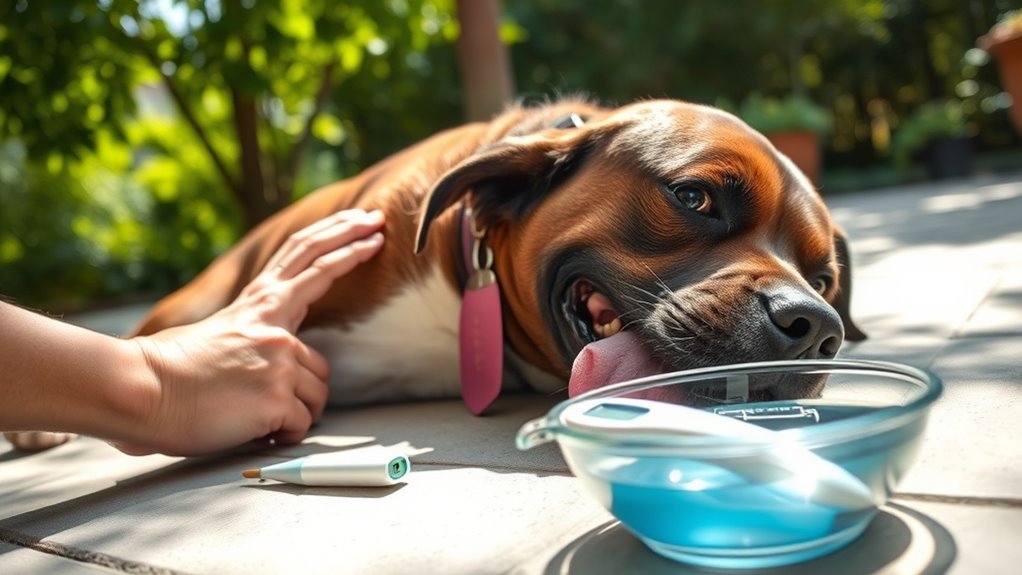
If you suspect your dog has heatstroke, move them to a shaded area immediately to reduce further heat exposure. Next, start cooling them down gradually with water or a fan, avoiding rapid temperature drops. These quick actions can help prevent serious complications and stabilize your dog until professional help arrives. Recognizing trust issues early can also be crucial in preventing long-term health impacts. Additionally, being aware of signs of heatstroke severity can guide your response and ensure prompt treatment. Incorporating sound healing science principles, such as gentle vibrations, can potentially support calming your dog during stressful situations.
Move to Shade Quickly
When you notice signs of heatstroke in your dog, moving them to shade is the top priority. Find a spot with good shade placement to shield them from direct sun exposure. This helps reduce their body temperature and prevents further overheating. Avoid leaving your dog in open, sunlit areas, as continued sun exposure worsens their condition. Gently move them to a cooler, shaded area as quickly as possible, ensuring they’re out of direct sunlight. Keep them calm and still while you prepare to cool them down further. Remember, the goal is to minimize additional heat gain. Utilizing natural shade sources can be especially effective in providing relief. Providing access to adequate hydration is also crucial during this critical time. Additionally, monitoring their body temperature with a rectal thermometer can help assess if they are cooling down effectively. Don’t delay—immediately relocating your dog to a shaded spot can make a significant difference in their recovery.
Cool Down Gradually
As soon as you’ve moved your dog to a shaded area, it’s important to start cooling them down gradually. Use cool, not freezing, water to lower their body temperature gently. Offer hydration strategies like small amounts of water or electrolyte solutions to prevent dehydration, but don’t force them if they’re vomiting. During this process, grooming tips can help—remove excess fur to improve heat dissipation. Remember, rapid cooling can cause shock, so monitor closely. Here’s a quick guide:
| Cooling Method | Hydration Strategy | Grooming Tips |
|---|---|---|
| Tepid water baths | Small sips of water | Trim excess fur |
| Cool compresses | Electrolyte solutions | Keep fur damp |
| Fan or air circulation | Avoid cold water | Avoid overcooling |
| Gradual cooling | Encourage drinking | Focus on shaded areas |
Additionally, understanding the importance of preventing heatstroke can help you act swiftly and effectively during such emergencies. Recognizing early symptoms can facilitate prompt intervention and potentially save your dog’s life. Being familiar with the signs of heat exhaustion allows for quicker response and better outcomes. Knowing the risk factors associated with heatstroke can help prevent it from occurring in the first place.
Moving Your Dog to a Cooler Environment
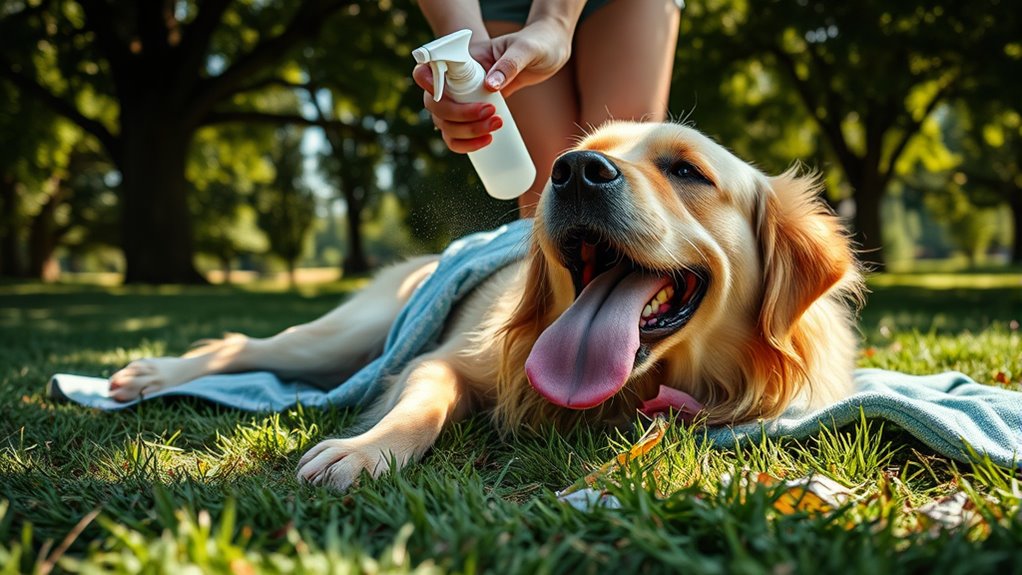
Moving your dog to a cooler environment quickly is essential to help prevent heatstroke from worsening. Find a shaded, air-conditioned space or move indoors immediately. Confirm hydration management by offering small amounts of cool water, but don’t force your dog to drink if they’re unconscious or vomiting. Keep your dog calm and avoid strenuous activity during the move. When outdoors, prioritize outdoor safety by avoiding hot surfaces like pavement or asphalt, which can burn their paws and increase body temperature. Use a towel or blanket to gently transport them if needed, and keep them wrapped in a cool, damp cloth during transit. Acting swiftly to relocate your dog to a cooler environment can considerably reduce the risk of serious complications from heatstroke. Additionally, be aware of support hours for veterinary assistance if symptoms worsen or do not improve promptly. Recognizing proper cooling methods, such as applying cool (not cold) water or ice packs to the neck and groin, can further aid in reducing their body temperature effectively. Understanding the signs of heatstroke can help you act more quickly and effectively in emergency situations. Being familiar with dog breeds that are more susceptible to heatstroke can help prevent future incidents and ensure your pet’s well-being.
Cooling Techniques to Use in an Emergency
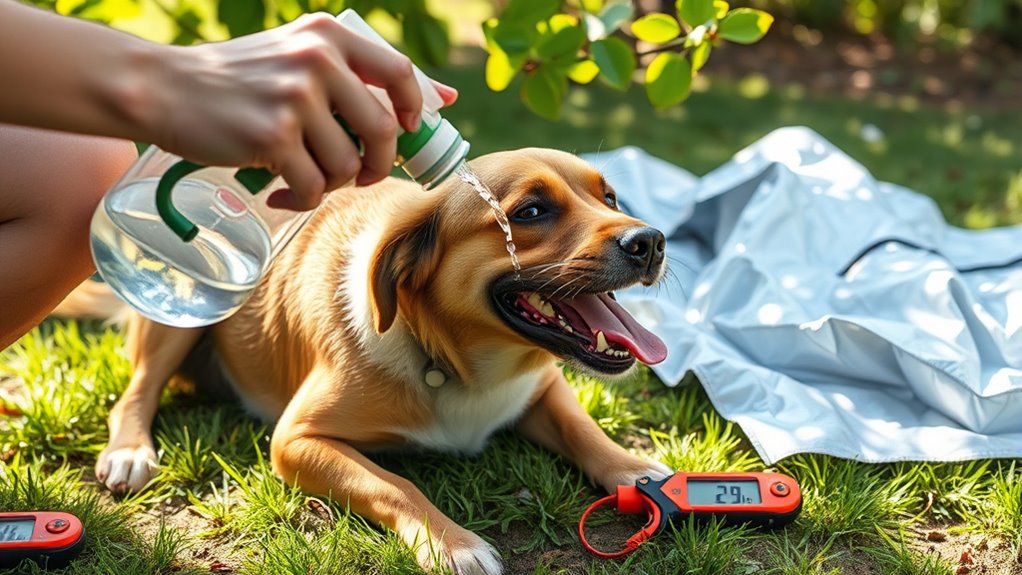
In an emergency, quickly applying cooling techniques can make the difference between life and death for a dog experiencing heatstroke. Start by providing hydration strategies, such as offering small amounts of cool, fresh water if the dog can swallow. Avoid forcing water if the dog is unconscious. Next, move your dog to outdoor shade or a shaded area to reduce heat exposure. Use cool, damp towels or cloths on their neck, underarms, and groin to help lower body temperature. Avoid ice-cold water or ice packs, as they can cause vasoconstriction. Focus on gentle, consistent cooling to prevent shock. Keep the dog still and monitored until professional help arrives. Incorporating air circulation by using a fan can also aid in cooling the dog more efficiently. Proper cooling techniques can stabilize your dog’s condition and save their life, especially when combined with knowledge of heatstroke symptoms to recognize early warning signs. Additionally, understanding dog heat tolerance can help prevent overheating in the first place. Regularly monitoring your dog’s body temperature can help catch signs of heat stress early and prompt timely intervention.
Monitoring Your Dog’s Body Temperature
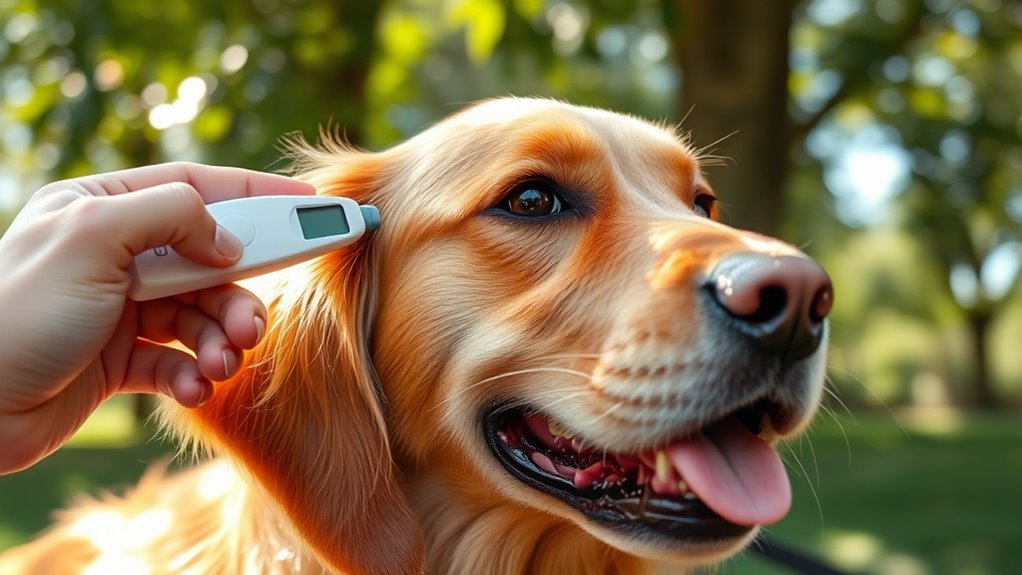
You need to keep a close eye on your dog’s body temperature to catch heatstroke early. Learn how to recognize when the temperature is dangerously high, and make sure you use a reliable thermometer correctly. This way, you can act quickly and effectively to keep your dog safe. Incorporating monitoring techniques can help you detect early signs of heatstroke and respond promptly. Regularly tracking body temperature with accurate tools enhances your ability to intervene before the situation worsens. Using proper thermometry methods ensures accurate readings and better decision-making during emergencies. Additionally, understanding lifestyle factors such as outdoor activity levels can assist in prevention and timely response.
Recognizing Elevated Temperatures
Monitoring your dog’s body temperature is essential for detecting heatstroke early. Elevated temperatures often cause noticeable signs like a hot, dry paw pad or rapid panting. Pay attention to changes in tongue color; a bright red or purple tongue can indicate overheating. If your dog’s temperature rises above 103°F (39°C), it’s a clear warning sign. You might also notice lethargy, weakness, or excessive drooling. These cues help you recognize when your dog is at risk, even before severe symptoms develop. Promptly noticing these signs allows you to take immediate action, such as moving your dog to a cooler place and offering water. Monitoring these subtle indicators is crucial for preventing heatstroke from escalating into a life-threatening emergency. Being aware of regional divorce statistics can help you understand the importance of quick response and support in emergency situations.
Using a Thermometer Properly
To accurately assess your dog’s body temperature, it’s important to use a reliable digital or rectal thermometer designed for pets. Gently lift your dog’s tail and carefully insert the thermometer into the rectum, about one inch for small dogs and two inches for larger ones. Hold it steady until it beeps. Keep an eye on your dog’s behavior; signs of discomfort or agitation may indicate distress. Monitoring temperature helps you recognize early signs of heatstroke and emphasizes the importance of hydration. If your dog’s temperature exceeds 103°F, seek veterinary care immediately. Proper use of a thermometer ensures accurate readings, allowing you to act swiftly. Remember, consistent monitoring and understanding dog behavior are key to preventing heat-related emergencies.
When to Seek Veterinary Assistance
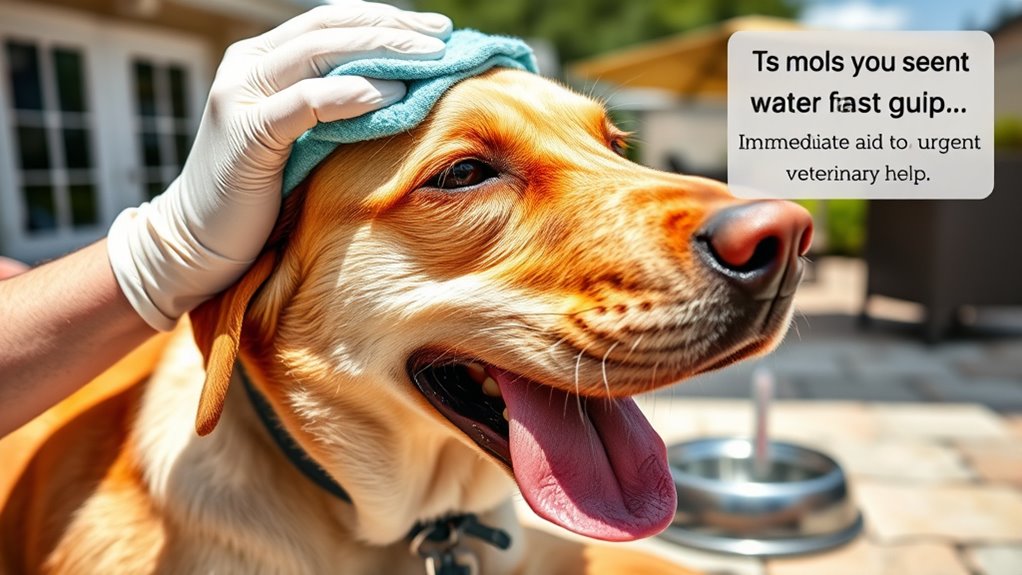
Immediate veterinary attention is crucial if your dog shows signs of severe heatstroke, such as unresponsive behavior, seizures, or difficulty breathing. If you notice these symptoms, don’t delay—seek professional help immediately. You should also consult a vet if your dog:
Seek immediate vet care if your dog shows unresponsiveness, seizures, or difficulty breathing.
- Stops responding to stimuli or becomes unconscious
- Experiences persistent vomiting or diarrhea
- Shows signs of rapid or labored breathing
- Exhibits worsening confusion or disorientation
While waiting for help, guarantee your dog’s hydration by offering small amounts of water if they can swallow. Move your dog to an outdoor shade or a cooler environment to help lower their body temperature. Prompt action can prevent long-term damage and save your dog’s life.
Preventative Measures to Avoid Heatstroke
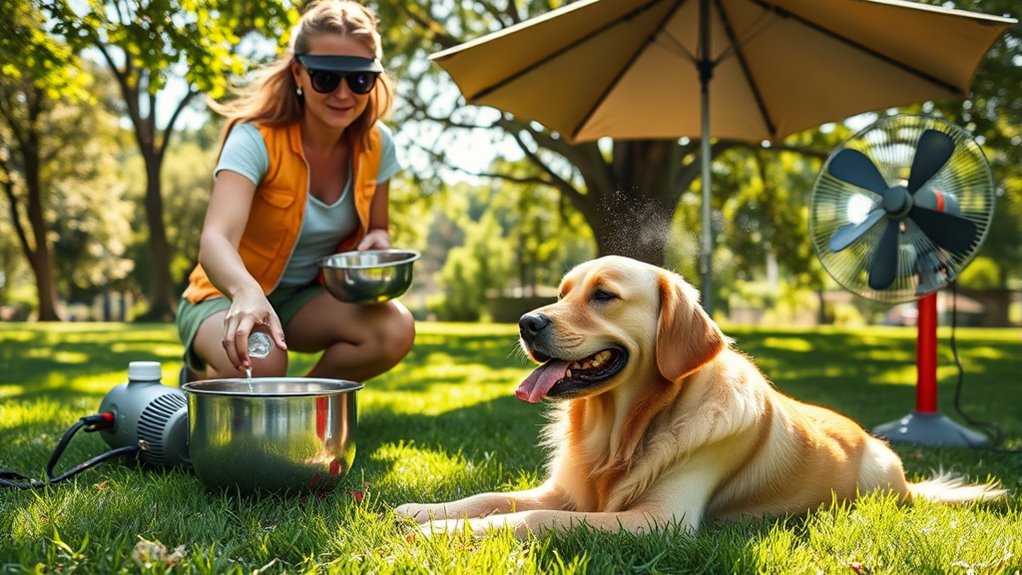
Taking proactive steps can considerably reduce your dog’s risk of heatstroke, especially during hot weather or outdoor activities. Implementing proper hydration protocols is essential; always provide fresh water and encourage regular drinking. Be aware of breed-specific risks—brachycephalic breeds, for example, are more prone to heat-related issues, so extra caution is needed. To stay ahead, monitor your dog’s activity level and avoid peak heat hours. Create shaded areas and limit strenuous exercise in high temperatures. Use the following table to help you remember key measures:
| Hydration Protocols | Breed-Specific Risks |
|---|---|
| Offer water frequently | Brachycephalic breeds at higher risk |
| Carry water on outings | Short-nosed breeds prone to overheating |
| Prevent overexertion | Dark-colored or thick-coated breeds more vulnerable |
| Ensure shade availability | Older dogs or those with health issues need extra care |
Common Mistakes to Avoid During First Aid
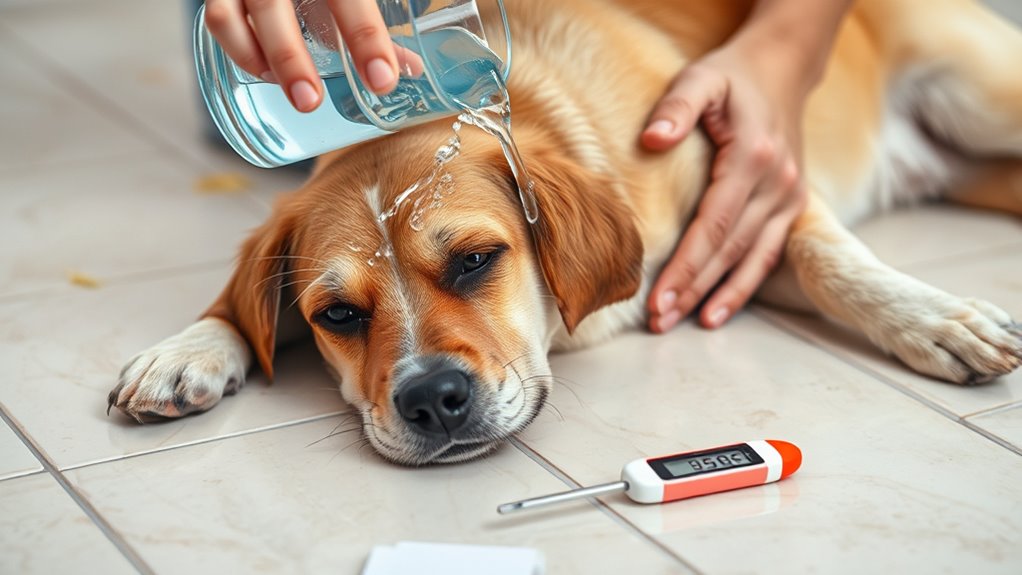
While knowing how to prevent heatstroke is essential, understanding common mistakes during first aid can make all the difference. Mistakes in first aid can worsen your dog’s condition or delay proper recovery. Be careful not to:
Avoid common first aid mistakes that can worsen your dog’s condition or delay recovery.
- Use cold water or ice directly on your dog, which can cause shock or tissue damage.
- Overly vigorous cooling, like excessive rubbing, that might stress your dog further.
- Delay seeking professional veterinary help when symptoms worsen or don’t improve.
- Give your dog food or water too quickly, risking choking or further stress.
Post-Crisis Care and Recovery Tips
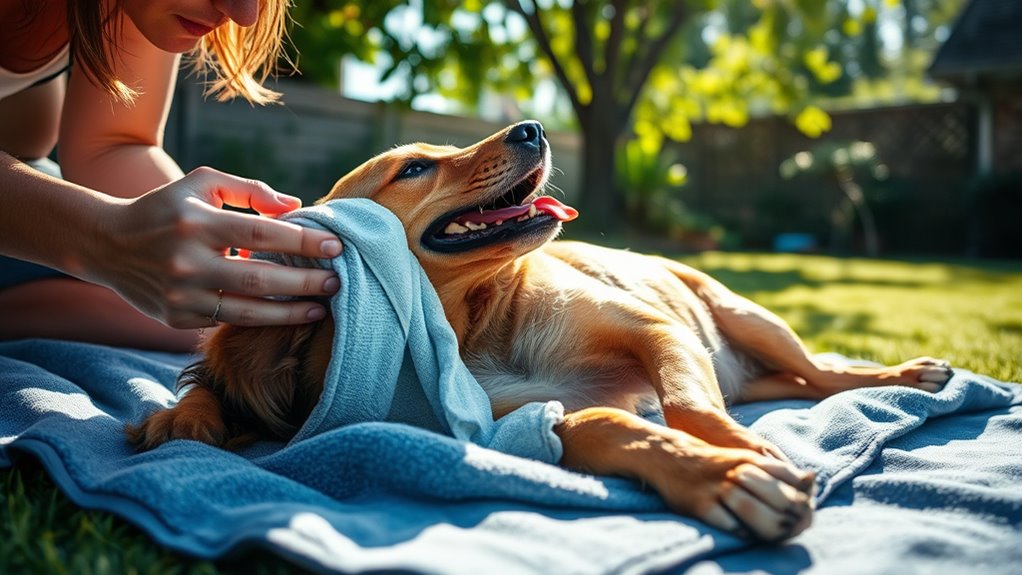
After a heatstroke incident, your priority is to make certain your dog’s smooth recovery by monitoring their condition closely. Ensure they stay well-hydrated with fresh water, as dog hydration is crucial for recovery. Keep them in a cool, shaded environment to prevent further heat exposure and avoid any strenuous activity. Observe for lingering symptoms like weakness, disorientation, or continued high temperature, and consult your veterinarian if needed. To support their healing, limit outdoor time and provide a comfortable resting space. Educate yourself on heat exposure prevention to avoid future incidents. Regularly check your dog’s temperature and behavior, especially during hot weather, and take proactive steps to keep them safe from heat-related dangers. Proper post-crisis care helps ensure a full recovery.
Frequently Asked Questions
Can Certain Dog Breeds Be More Prone to Heatstroke?
Some dog breeds are more prone to heatstroke due to breed susceptibility and coat considerations. Breeds like Bulldogs, Pugs, and French Bulldogs have short noses, making breathing harder in hot weather. Dogs with thick, double coats, such as Siberian Huskies, also risk overheating quickly. You should be extra cautious with these breeds, providing plenty of shade, water, and avoiding outdoor activity during peak heat to keep them safe.
How Can I Prevent Heatstroke During Outdoor Activities?
To prevent heatstroke during outdoor activities, you should implement effective hydration strategies by providing your dog with plenty of water and frequent breaks. Always guarantee there are shaded areas where your dog can rest and cool down. Avoid the hottest parts of the day, typically between 10 a.m. and 4 p.m., and monitor their behavior closely. These steps help keep your dog safe and comfortable in the heat.
What Are Long-Term Effects of Heatstroke in Dogs?
You should know that heatstroke can have serious long-term effects on your dog’s health. It may cause lasting neurological damage, affecting their coordination, behavior, or cognitive functions. Some dogs might experience persistent health issues, such as organ damage or chronic fatigue. Recognizing symptoms early and seeking prompt veterinary care can reduce these risks. Regularly monitoring your dog during hot weather helps prevent long-term health problems related to heatstroke.
Is It Safe to Give My Dog Water Immediately After Heatstroke?
You might wonder if giving your dog water immediately after heatstroke is safe. It’s important to prioritize hydration safety by offering small amounts of water gradually, rather than letting them drink too much at once. Controlled water intake helps prevent vomiting or further stress. Always monitor your dog closely and consult your veterinarian for personalized advice. Proper hydration support is vital for recovery, but do so carefully to avoid complications.
How Often Should I Check My Dog’S Temperature During Recovery?
Think of monitoring your dog’s temperature like tuning a delicate instrument—you need to check frequently but carefully. During recovery, you should check your dog’s temperature every 10-15 minutes until it stabilizes below the critical threshold of 103°F. After that, you can extend checks to every 30 minutes. This helps guarantee you catch any signs of relapse early and keep your dog safe during recovery.
Conclusion
By recognizing symptoms, taking swift action, and preventing heatstroke, you protect your dog’s health and happiness. By staying vigilant, acting quickly, and providing proper care, you guarantee your furry friend’s safety and well-being. By understanding signs, implementing cooling techniques, and seeking veterinary help when needed, you foster trust and security. Ultimately, by being prepared, attentive, and proactive, you create a safe environment where your dog can thrive, even in the hottest days.










